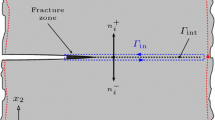Abstract
This paper presents a three-dimensional crack initiation analysis in a sidegrooved CT specimen. This is achieved with an endochronic damage model proposed recently by Chow and Chen [1, 2] and discretized for finite element analysis. The damage model enables the quantification of the progressive damage evolution which would not be otherwise possible using the conventional fracture mechanics analysis. By employing two separate damage failure criteria, the crack is predicted to initiate at a small distance from the sidegroove and the prediction agrees well with the experimental observation. A more uniform crack initiation across the crack-tip line is observed both experimentally and theoretically relative to the CT specimen without sidegrooving.
Similar content being viewed by others
References
C.L.Chow and X.F.Chen, An anisotropic model of continuum damage mechanics based on endochronic theory of plasticity. International Journal of Fracture 55 (1992) 115–130.
C.L.Chow and X.F.Chen, Failure analysis of a cracked plate based on endochronic plastic theory coupled with damage, International Journal of Fracture 60 (1993) 49–63.
C.L.Chow and X.F.Chen, Three-dimensional fracture analysis of CT specimen with a ductile damage model based on endochronic plasticity theory, International Journal of Fracture 69 (1995) 229–249.
H.G.DeLorenzi and C.D.Shih, 3-D elastic-plastic investigation of fracture parameters in side-grooved compact specimen, International Journal of Fracture 21 (1983) 195–220.
C.F. Shih et al., Studies on crack initiation and stable crack growth, in Elastic-plastic Fracture, ASTM STP 668 (1979) 65–120.
H.C.Wu et al., Further application of endochronic constitutive equation to loading with non-proportional axial-torsional strain-path, International Journal of Non-Linear Mechanics 20, 1 (1985) 41–52.
H.C.Wu et al., Analysis of stress response to various strain-paths in axial torsional deformation of metals, Transtactions ASME, Journal of Engineering Materials and Technology 106 (1984) 361–366.
O.Watanabe and S.N.Alturi, Internal time general internal variable and multi yield surface theory of plasticity and creep: a unification of concepts, International Journal of Plasticity 2 (1986) 37–57.
F.A. McClintock, A criterion for ductile fracture by the growth of holes, Transactions ASME, Journal of Applied Mechanics (1968) 363–371.
J.R.Rice and D.M.Tracey, On the ductile enlargement of voids in triaxial stress fields, Journal of the Mechanics and Physics of Solids 17 (1969) 201–217.
J.W. Hancock and M.L. Cowling, Role of state of stress in crack-tip failure processes, Metal Science (1980) 293–304.
H. Ziegler, An introduction to thermomechanics, in North Holland Series in Applied Mathematics and Mechanics (1977) Chapter 14.
Author information
Authors and Affiliations
Rights and permissions
About this article
Cite this article
Chow, C.L., Chen, X.F. Damage development in a sidegrooved CT specimen based on a 3-D endochronic damage model. Int J Fract 79, 209–224 (1996). https://doi.org/10.1007/BF00019378
Received:
Accepted:
Issue Date:
DOI: https://doi.org/10.1007/BF00019378




